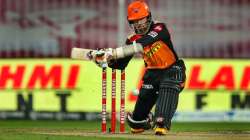UAE's sand-based grounds reason behind key Indian players suffering hamstring injury
Ishant Sharma, Wriddhiman Saha, Vijay Shankar, Ambati Rayudu and Rishabh Pant have all suffered hamstring injury or strain during the tournament while Bhuvneshwar Kumar had to pull out due thigh muscle injury.

At least five India players, including India's limited-overs skipper Rohit Sharma, have suffered hamstring injury or strain during the Indian Premier League (IPL). Playing after a long layoff due to Covid-19 lockdown could be the main reason for this; the sand-based outfields in the United Arab Emirates (UAE) have also emerged as another.
Besides Sharma, Wriddhiman Saha, Vijay Shankar, Ambati Rayudu and Rishabh Pant have all suffered hamstring injury or strain during the tournament while Bhuvneshwar Kumar had to pull out due thigh muscle injury. Three of them have been selected to tour Australia this month.
Murali Kartik, former cricketer-turned-commentator, had pointed this out during a match last week. "A reason for players getting injured during the tournament is that these are sand-based grounds," he had said.
The outfields in Sharjah, Dubai, and Abu Dhabi are made entirely of sand which is softer and puts a lot more strain on the hamstring.
This is the first time an entire edition of IPL was played in the UAE. Back in 2014, the BCCI hosted only 20 games in the UAE.
In India, the home of the lucrative tournament, many of the grounds have soil mixed in the outfield with only a top dressing fine of sand. The dressing, too, has fine sand and organic matter.
"The sand-based outfields are softer than the soil-based outfields. In India, all the newer stadia being built have purely sand-based outfields as the water drains out faster in these and also the grass grows better and evenly as they irrigate better. And because sand is softer than soil that was used earlier, it is safer for fielding also," said Daljeet Singh, the former head of BCCI pitches and grounds committee.
"However, in many grounds in India that have been there for some time, only a top dressing of fine sand [mixed with organic matter] is done. What happens, generally, is that on purely sand-based outfields, the metal spikes of players, especially the bowlers, go much deeper than into soil-based surfaces. When they pull those out, there is some effort and it puts some strain on the hamstring," he said.
Singh, a former first-class cricketer, said: "On soil-based outfields, the outfield is hard, inconsistent, at some place there will be a patch of grass or a patch of brown. The players' spikes don't go that deep and they will just mark the surface on the top and come out."
In India, the older grounds like Eden Gardens, Wankhede Stadium, Ferozeshah Kotla or Mohali are soil-based with top dressing of fine sand and organic matter. The new ground like the Punjab Cricket Association Stadium in Mullanpur is completely sand-based.